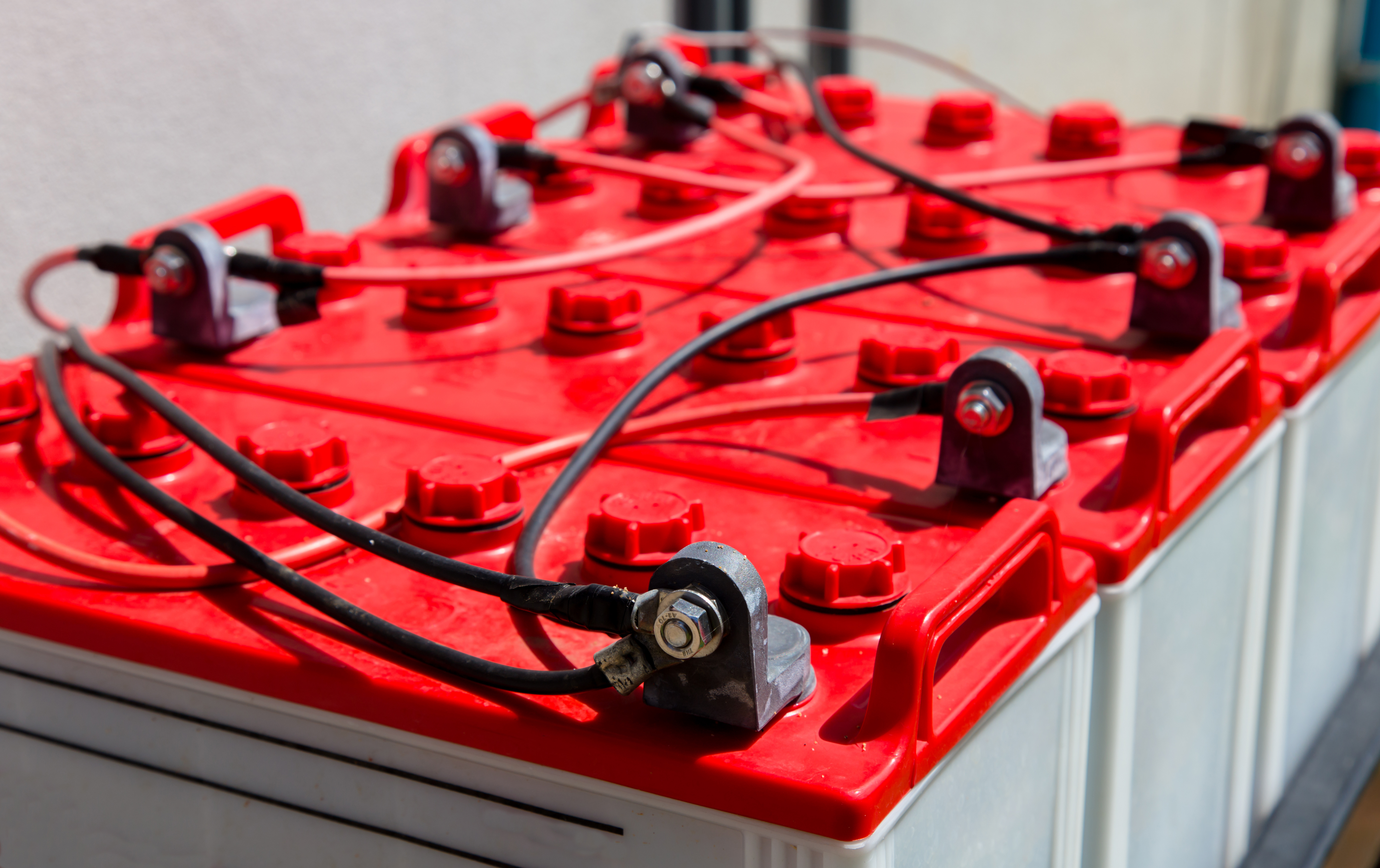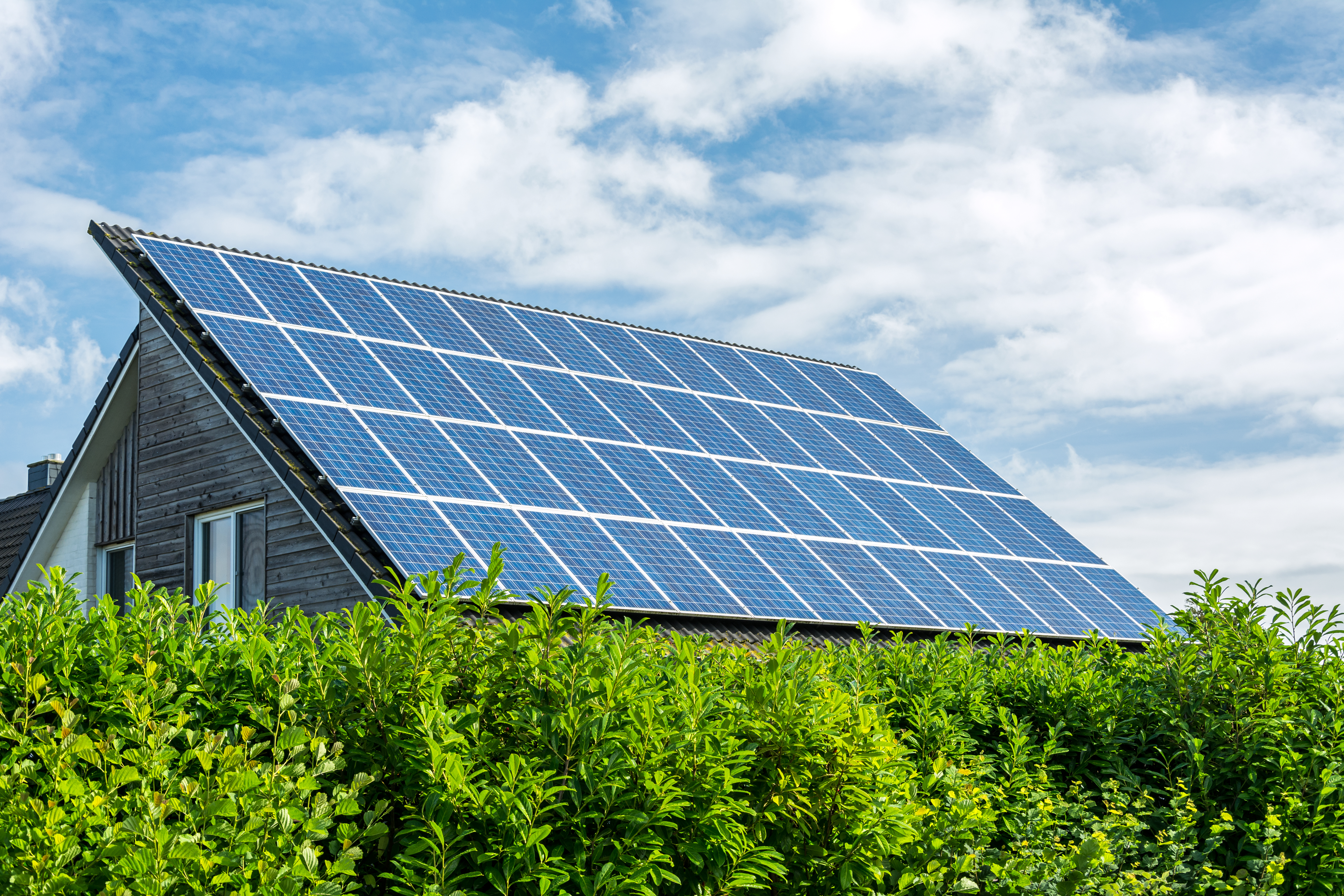Home Solar Battery Guide

Going solar is no longer a luxury for Americans with disposable income. The cost of installing solar panels has dropped roughly 70 percent in the past decade, making these renewable energy systems accessible to the everyday homeowner. A convenient add-on to solar power systems, solar batteries provide a way to back up energy and have also become more cost-effective in recent years. Solar batteries store surplus solar power that homeowners can use later to power their homes. If you already have a home solar power system or you’re thinking of investing in one, it’s wise to consider adding battery backup as well.
Solar Batteries for Home Use
A residential solar energy system is made up of multiple parts that all work together: solar panels that absorb sunlight, an inverter that changes the sun’s energy into usable electricity, mounting equipment, and monitoring devices that track how much electricity your panels generate.
Many residential solar energy systems are directly tied to the main electrical grid. If your solar panels produce more electricity than your home needs, the excess may be sent to the power grid. On the flip side, if your solar panels aren’t producing enough electricity to power your home, you can tap into the electric grid to bridge the gap.
Depending on where you live, homeowners may receive a utility bill credit for any extra electricity your panels generate that is sent to the main power grid. This process is called “net metering” and a majority of states and territories have passed enabling legislation. Net metering gives homeowners the chance to use those utility bill credits during periods when their solar panels aren’t generating enough power.
How do Solar Batteries Work?
Solar batteries store the energy your solar panels produce, so that you can access this power later when you need it – at night or during dreary or rainy days – rather than sending the excess electricity back to the power grid. The only time your solar power system would send electricity back to the grid is if your solar batteries are fully charged.
Although not all solar power systems with batteries are grid-tied, if your home is connected to the main power grid, you can still draw electricity from it when your batteries are fully depleted. The larger your battery’s capacity, the more solar energy it can store, and the more power you can tap when you need it.
Note: Residential batteries are usually paired with home solar panel systems, but they can still be useful for homeowners without solar power. For short-term power storage, home batteries can be charged with electricity from the grid and provide emergency power during a blackout without the need for a diesel generator.

Types of Solar Batteries
Most residential solar batteries will work with your existing solar panel system. Understand that many batteries won’t be able to take you fully off the grid, as this is a common misconception A majority of residential solar power batteries simply don’t offer enough storage to power your home for very long on their own. And, there’s a major downside to living off the grid: in the event of inclement weather like a snowstorm or extended periods of rain or clouds, you’ll be out of luck trying to power your home.
Creating an off-the-grid system is typically going to be more expensive and labor-intensive. In fact, these systems cost upwards of $70,000 for parts alone. Labor generally accounts for around 10% of the total project cost.
For homeowners who want to take on a more moderately priced solar project, a hybrid system that offers both home solar battery storage and a connection to the electrical grid is ideal. Below, we’ve outlined some of the home solar battery choices you’ll see on the market.
Lead-Acid battery:
One of the oldest forms of chemistry used in energy storage, lead-acid batteries are dependable and inexpensive. Unfortunately, they come with a few drawbacks. They typically have a short lifespan and a low depth of discharge (DoD).
Note - The depth of discharge (DoD) of a battery describes how much of the battery’s capacity can be used. So, if a battery has a higher DoD, you’ll be able to use more of the battery’s total capacity.
Lithium-Ion battery:
You might already be familiar with lithium-ion batteries because they’re the same type of batteries that power electric cars. They’re becoming a popular choice for homeowners looking for a dependable solar battery that’s light, compact, and efficient.
Lithium-ion batteries boast long lifespans, as well as high discharge and recharge rates. They are, however, more expensive than lead-acid batteries.
NiCad (Nickel Cadmium) battery:
NiCad batteries are expensive to buy but provide long lifespans, high reliability, and forgiving performance, especially in extreme temperatures. For these reasons, they’re a popular choice for more extreme off-the-grid homesteads.
Although these are durable batteries, the end of their lifespan comes with an unfortunate amount of hassle. They are expensive to properly dispose of because cadmium is a hazardous material.
Ni-Fe (Nickel Iron) battery:
With a Ni-Fe battery, the output voltage can vary widely, so the inverter paired with this option must be designed to withstand those variances. If your solar power system depends on a stable voltage, you might not be able to use this type of solar house battery.
Sodium-Based (Saltwater) battery:
In the world of solar power batteries for home, sodium-based batteries are a newcomer. Using sodium or saltwater electrolytes, these batteries contain no heavy metals. For homeowners, this means less hassle at the end of the battery’s life cycle since it can be easily recycled.
Sodium-based batteries offer a long lifespan but lower overall energy density, so they’re physically larger. They’re also less popular since this technology is so new and less commercially available compared to the other types of residential solar batteries.

Benefits of Solar Battery Storage
The advantages of solar energy battery storage include:
-
Power when you need it: A solar house battery system delivers power when you need it, even if it’s cloudy outside or nighttime.
-
Energy security: If you live in an area with poor grid management, solar batteries offer greater independence from local energy sources.
-
Potentially lower electric bills: If you’re required to pay time-of-use (TOU) rates for your electricity or pay for monthly demand charges, you may save money by drawing from your own solar batteries when rates spike.
-
Lower carbon footprint: Using electricity from your solar panel system and solar batteries means that you’re using fewer fossil-fuel resources.
Curious about whether solar energy is right for you? Our guide to residential solar myths and truths can clear up some common misconceptions.
How many solar batteries are needed to power a house?
To determine the size of your solar battery bank, you’ll need to crunch some numbers and know your household’s power consumption. Energy is measured in kilowatt-hours (kWh) over a set period of time.
So, if you use 1,000 watts for 10 hours each day, your energy use is 10kWh per day.
The key to solar battery sizing is investing in enough batteries to handle the load from your solar panels while providing you with enough stored power so that you don’t force your batteries to discharge beyond what’s considered “healthy” (below 30-50% of the batteries’ total capacity).
Other variables affecting your solar battery storage system include:
-
The desired number of days before needing to recharge
-
A battery bank’s ability to compensate for energy fluctuations
-
The length of time your total power reserve would take to be fully depleted (the more amp hours your battery bank provides, the longer it will take for the batteries to deplete)
The basic rule-of-thumb is that the larger your batteries’ capacity and the more batteries you have, the better it is for you as a homeowner, and the better it is for the batteries’ longevity.
Solar battery manufacturers and distributors typically offer online calculators to help determine your battery bank sizing, but the general standard calculation is:
Watts = Amps x Volts
So, if you use 1,000 watt-hours (1kWh) a day and select a 12-volt battery bank, you’ll need 84 amp-hours of storage. But, it’s a good idea to incorporate a reserve capacity so you’re not pushing your batteries into the “unhealthy” range of depletion. The formula for your “true” amp hours is the same as amp-hours above (84) multiplied by two. So in reality, you would want a 168 amp hours system. This creates a safety buffer that can keep your home powered during electricity surges – for example, when you start up your microwave.
How much are solar batteries for homes?
Adding batteries to your solar power system is a relatively easy process. Batteries are usually installed into the ground, typically in a garage or shed. The labor cost to add a battery can be around $5,000–$7,000, but that’s a ballpark estimate and doesn’t take into account your specific residential location, the number of solar panels you have, and the cost of electrician services in your area.
To get a customized estimate for installing solar batteries, contact a trusted Ygrene contractor for a personalized quote.
Takeaways: Investing in Solar Batteries and Your Home’s Energy Independence
If you already have a solar power system for your home, adding a home solar battery bank is a smart addition. Home solar batteries can help you withstand sudden energy emergencies and provide peace-of-mind. With Ygrene PACE financing, investing in solar batteries is affordable and convenient. If you’re ready to reduce your carbon footprint and enjoy a more secure energy future, contact Ygrene today to see if PACE financing is available in your area.




